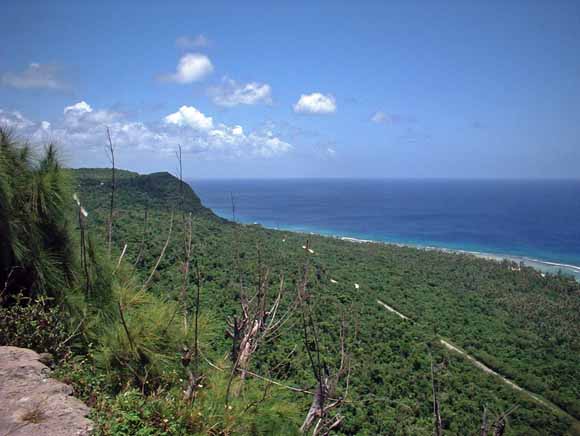Pacific Island Ecosystems Research Center

Ritidian Point
Limestone forests are the most diverse natural plant communities of Guam. Like other natural vegetation types, these forests have a long history of anthropogenic disturbances, being altered and shaped by humans for more than 4,000 years. Although this occupation represents a relatively long human influence in comparison to other Pacific islands, animals associated with humans, such as commensal rodents, arrived in these islands beginning only 1,000 years ago, and larger mammals, such as pigs (Sus scrofa), may not have arrived until European contact. Limestone forests, which also occur on several other Mariana Islands, developed in the presence of frequent tropical storms and are therefore well adapted to this type of natural disturbance regime. However, recent human activities including large scale clearing and conversion combined with the presence of high levels of alien herbivores and seed predators, and the loss of ecological services provided by the former native avifauna may be causing the decline of Guam's forests. Limestone forests on northern Guam, much like those of other Mariana Islands, were heavily cleared for the construction of military installations during World War II. The accidental introduction of the Brown Tree Snake (Boiga irregularis; BTS) around this same period subsequently accelerated the disappearance of Guam's native avifauna and other endemic terrestrial vertebrates, and with them, seed dispersal, pollination, and the predatory regulation of herbivorous insects.
Guam and the Mariana Islands contained a high proportion (32 pecent) of endemic bird species, with 4 forms endemic to Guam alone: the now extinct Guam Flycatcher (Myiagra freycineti), and Guam Bridled White-eye (Zosterops conspicillatpicillata), one of three island endemic subspecies from the Marianas; Guam rail (Rallus owstonii); and Guam Kingfisher (Todiramphus cinnamominus cinnamominus), an island endemic subspecies of the regionally endemic Micronesian Kingfisher. Guam once supported the Mariana Gallinule (Gallinula chloropus guami), the Mariana Mallard (Anas platyrhynchos oustaleti), Mariana Fruit-Dove (Ptilinopus roseicapilla), White-throated Ground Dove (Gallicolumba xanthonura xanthonura), Mariana Crow (Corvus kubaryi), and the Nightingale Reed-warbler (Acrocephalus luscinia), all endemic to the Mariana Islands. Other regionally endemic endangered species include the Micronesian Megapode (Megapodius laperouse), and the Mariana Swiftlet (Aerodramus bartschi), now reduced to a small population on Guam.
Likewise, the flora of Guam is unique, with 21percent of its native vascular plants endemic to the Mariana Islands. In limestone forests of Northern Guam, a number of tall forest tree species such as joga, Elaeocarpus joga (Elaeocarpaceae); pengua or Macaranga thompsonii (Euphorbiaceae); ifit or Intsia bijuga (Fabaceae); seeded breadfruit or Artocarpus marianensis (Moraceae); and umumu or Pisonia grandis (Nyctaginaceae) may be in decline as a result of herbivory by mammals. All show reduced regeneration and age distributions highly skewed towards older individuals. These species provided important habitat for some of Guam's endangered forest birds that remain in captivity such as the Mariana Crow, Guam Kingfisher, and Guam Rail. The recent high frequency of intense tropical storms and herbivory caused by large populations of feral pigs and Philippine sambar deer (Cervus mariannus), as well as invasive alien vines that may suppress tree regeneration, could be permanently altering the structure of regenerating forests and composition of important canopy species on secondary limestone substrates that were cleared and compacted during airfield construction from 1944 through the 1970s. Guam National Wildlife Refuge (GNWR) was established at Ritidian Point, after it was determined to be excess property by the U.S. Navy. Most of the refuge, about 9,087 hectares, is an "overlay refuge" on lands administered by the U.S. Air Force and U.S. Navy. Although the military mission comes first on these lands, the U.S. Fish and Wildlife Service assists in protecting native species and habitats. The recovery of limestone forest on Guam for forest bird habitat may require intensive management, including reduction of feral herbivores, propagation, out-planting, weed control, and periodic suppression of herbivorous insects. Research to support these techniques may be best accomplished in small areas where potential limiting factors can easily be experimentally manipulated.
Area 50, a 24 ha enclosure, contains a relictual patch of relatively undisturbed limestone forest surrounded by tarmac allowing easy access and management opportunities to control alien mammals and snakes. These species have been periodically managed in the past, but recent typhoons have damaged snake-proofing on the enclosure fence. A new concrete barrier is planned to provide more permanent control opportunities within this enclosed area or another similar area, thereby allowing experimental research for various management regimes. Eradication and control of alien vertebrate and plant pests will provide habitat where native communities can be restored in a small, intensively managed area. The stated aim of this project is to "affect ecosystem restoration through the removal and exclusion of introduced species and the reestablishment and propagation of native species, with focus on the reintroduction of native forest bird species." This will be achieved by constructing a multispecies barrier surrounding the area, coordinated eradication of selected alien species within the area, and possible reintroduction of Mariana Crow, Guam Kingfisher, and Guam Rail. This barrier also allows experimental research questions to be addressed within the small enclosure around Area 50 that may be applied to manage and restore the larger areas of limestone forest on northern Guam and also similar forests on other islands of the Marianas.
Download this report as a 55-page PDF file (of2005-1299.pdf; 9.6 MB)
For questions about the content of this report, contact Steve Hess.
| Help
| PDF help
| Publications main page | Open-File
Reports for 2005 |
| Biological Resources |
Pacific Island Ecosystems Research Center
|